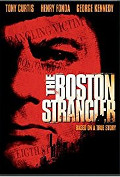
Directed by
Richard Fleischer
116 minutes
Rated M
Reviewed by
Bernard Hemingway

The Boston Strangler
There are two principal ways of looking at Richard Fleischer‘s film. One is as a film as such, the other is as history.
From the first perspective The Boston Strangler is a well-made film even despite the B-grade-typical dime store psychologising that it falls into in its second half. Fleischer makes extensive and effective use of split-screen effects in the first half of the film to whip us through the story of one of America’s most notorious serial killing sprees that left thirteen women dead over a two-year period 1962-1964, the city of Boston in the grip of fear and the police bumbling through a fruitless investigation (headed up by Henry Fonda’s John Bottomly). Somewhat less pertinently but symptomatic of the times we are also titillated with homosexuality, lesbianism and fetishism. This done, Fleischer introduces what remains Tony Curtis’s most famous performance as the hitherto unseen Boston Strangler, Albert DeSalvo. Although commendably against type Curtis ‘s performance is not in the league of, say that of Charlize Theron in Monster (2003) but it does call on the actor to do more than the romantic comedies that were his stock-in-trade, his relatively subdued performance justified by the fact that the real DeSalvo was apparently an affable chap.
From a historical perspective the film is less effective being based on a best-selling book by Gerold Frank who in turn based his account on information provided by DeSalvo’s attorney who in the way of American law was looking to monetize his client’s (and thereby his own) situation. The film adopts the view that DeSalvo, who confessed to the crimes was the Boston Strangler although there was no evidence to prove this. Even here scriptwriter Edward Anhalt takes considerable liberties with the facts, inventing the “split personality’ theory that is used to explain DeSalvo’s actions and ignoring the fact that he was already in jail on suspicion of 29 rapes when he confessed to the killings. In this respect the film is more of fictionalization (and some might even say, exploitation) of events than an attempt to portray them truthfully. Indeed a considerable number of people involved with the case were not convinced by DeSalvo’s confession.
FYI: DeSalvo was murdered in prison in 1973, apparently for selling amphetamines below the fixed rate. DNA testing conducted on his exhumed body in 2013 confirmed his connection to the Strangler’s last victim, Mary Sullivan.
Want something different?





